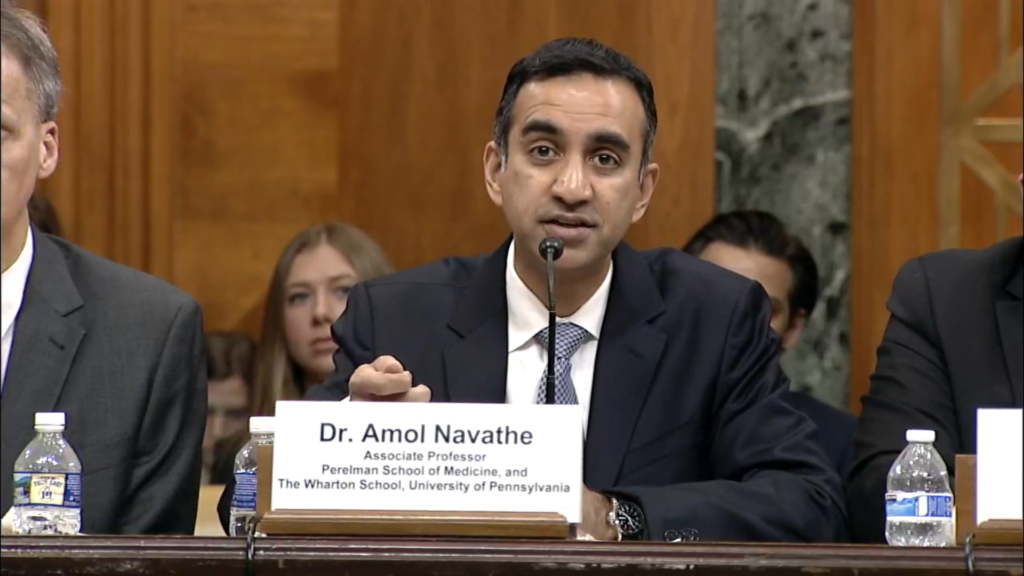Dr. Navathe Testifies About Primary Care Before U.S. Senate Committee on the Budget

CHIBE Associate Director Amol Navathe, MD, PhD, testified before the U.S. Senate Committee on the Budget about achieving health efficiency through primary care this March.
In his testimony, Dr. Navathe gave an overview of the current landscape of primary care, naming a few issues such as high rates of physician burnout, increased administrative burden and complexities due to new technologies, and the fee-for-service payment system, which incentivizes activity rather than health. He also noted inefficiencies in the Medicare Physician Fee Schedule (MPFS), beyond primary care services.
Dr. Navathe’s recommendations are to:
- Grant the Centers for Medicare & Medicaid Services (CMS) the authority to pay primary care practices through a hybrid primary care payment model.
- Address inefficiencies in the MPFS with independent expert input.
Hybrid Primary Care Payment Model
A hybrid primary care payment model leverages both the usual fee-for-service payments for certain services but also monthly payments to primary care clinicians for each Medicare beneficiary, adjusted for their level of illness. This incentivizes providers to perform the right kind of care, care that is high-value, and these fee-for-service payments can be regularly reassessed to ensure optimal care model delivery.
“Practices can use the flexibility and stability created by a predictable flow of monthly payments to deliver more patient-centered care, harnessing technology such as telehealth when it is efficient and effective, and through a staffing model that better represents today’s primary care workforce,” he said.
Dr. Navathe emphasized that Congressional action was needed to implement hybrid primary care payments and that the efforts to fix the country’s primary care infrastructure need to be implemented through CMS to be sustainable and permanent. He noted that hybrid primary care payment has been shown to decrease both hospitalizations and emergency department visits and increase quality.
“Simply put, until the majority of revenue to primary care practices comes from a hybrid payment system, we are unlikely to see any transformative shift in how care is delivered nationwide,” he said. “This transformative shift is critical because it will enable the scaling of leading indicators into lower spending.”
Inefficiencies in the MPFS
Dr. Navathe stated that the current payment rates in the MPFS create incentives for procedural services and undervalue diagnostic services, resulting in higher Medicare spending without improvements in patients’ health. The current schedule undervalues services provided by primary care physicians, he added. Some of the services that primary care physicians provide, like addressing social challenges, are not accounted for in the codes of the fee schedule. A hybrid primary care model can help address this underinvestment in primary care, Dr. Navathe said, but the weights of the codes and methodology need to be adjusted.
“The MPFS needs to be reweighted to address inefficiencies that lead to wasteful spending,” Dr. Navathe said. “This will require not only a re-examination of the weights themselves, but also, more importantly the methodology and process of determining weights. An independent group, free of any interest in the results itself, but having the right expertise and balanced representation across specialties, will be well situated to contribute to this task.”
Dr. Navathe spoke about his work with Blue Cross Blue Shield of Hawaii, or Hawaii Medical Services Association (HMSA), which tested hybrid payment payments for primary care through its Population-based Payments for Primary Care (3PC) model.
“The model led to marked improvements in quality, greater use of telehealth that predated the COVID-19 pandemic, and fewer low value imaging tests,” he said. “This included increased rates of cost-effective prevention like blood pressure control among patients with diabetes (2.7% differential increase), as well as greater cost-saving care such as a 5.5% differential increase in advance care planning.”
Dr. Navathe added that Hawaii’s primary care practice finances were protected during the COVID-19 pandemic because the infrastructure for taking care of patients remotely was already in place.
Concluding Remarks
In his concluding remarks, Dr. Navathe emphasized that these changes – implementing a hybrid payment system and reforming the MPFS—could help catalyze more cost-efficient health care and higher quality health care in the country.
Watch the committee video here; Dr. Navathe’s testimony starts around the 1-hour-19-minute mark.
In addition to serving as a CHIBE Associate Director, Dr. Navathe is also director of the Parity Center, whose mission is to reform health care payment to promote equitable health care delivery and outcomes. He is also Professor of Health Policy and Medicine at the Perelman School of Medicine, a
Staff Physician and Core Investigator with CHERP at the Philadelphia VA Medical Center, and Vice Chair and Commissioner, Medicare Payment Advisory Commission (MedPAC).